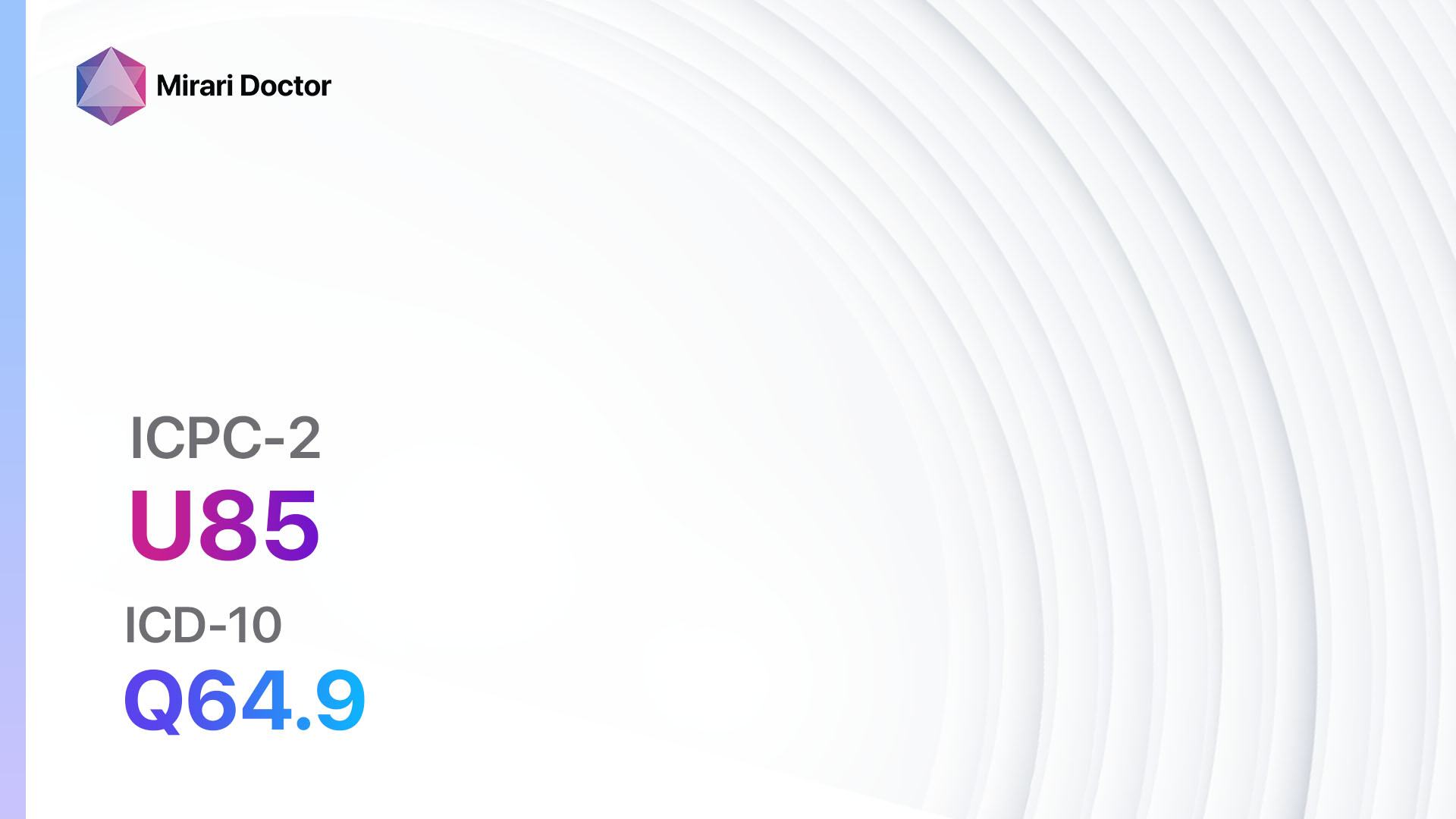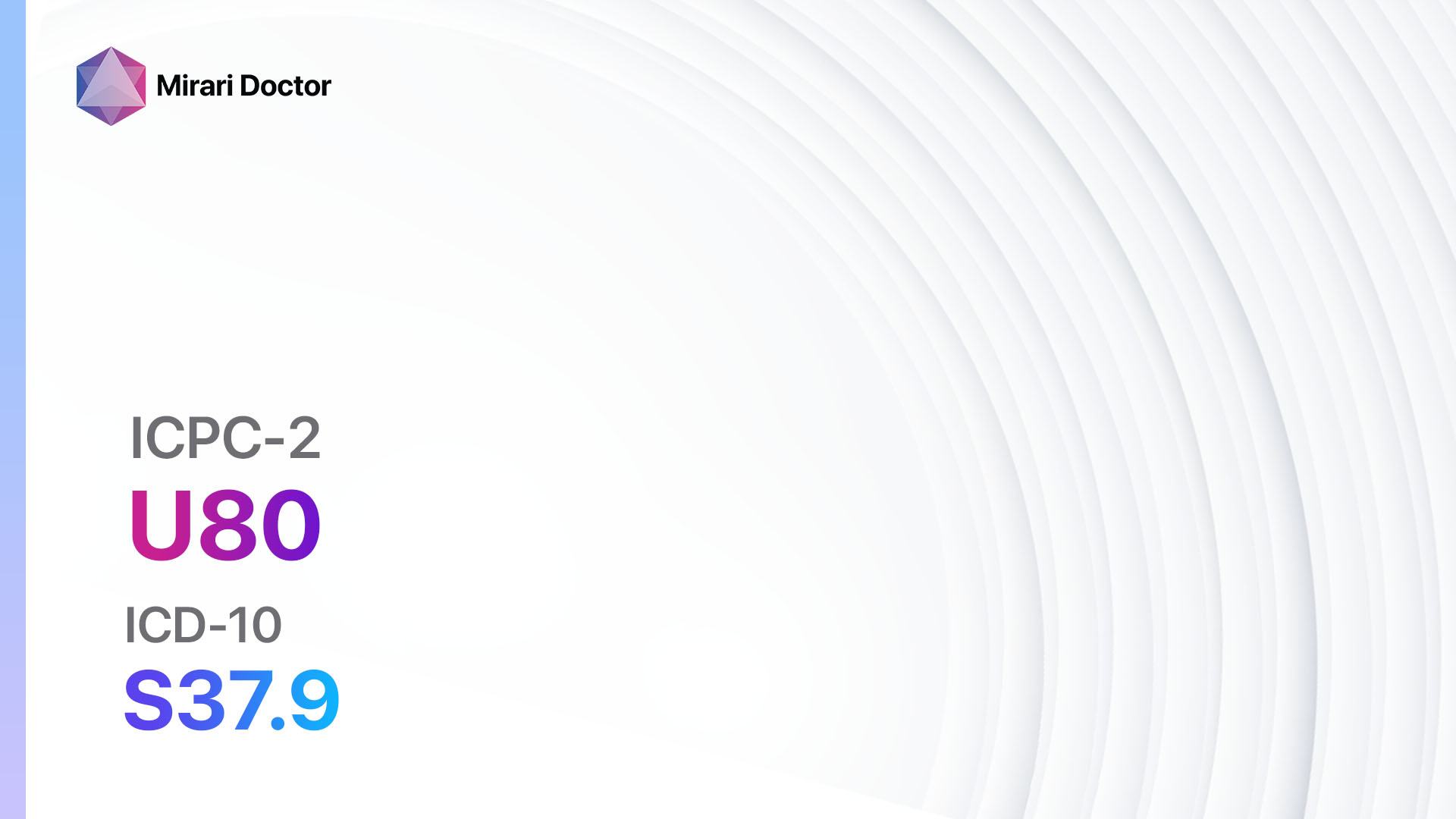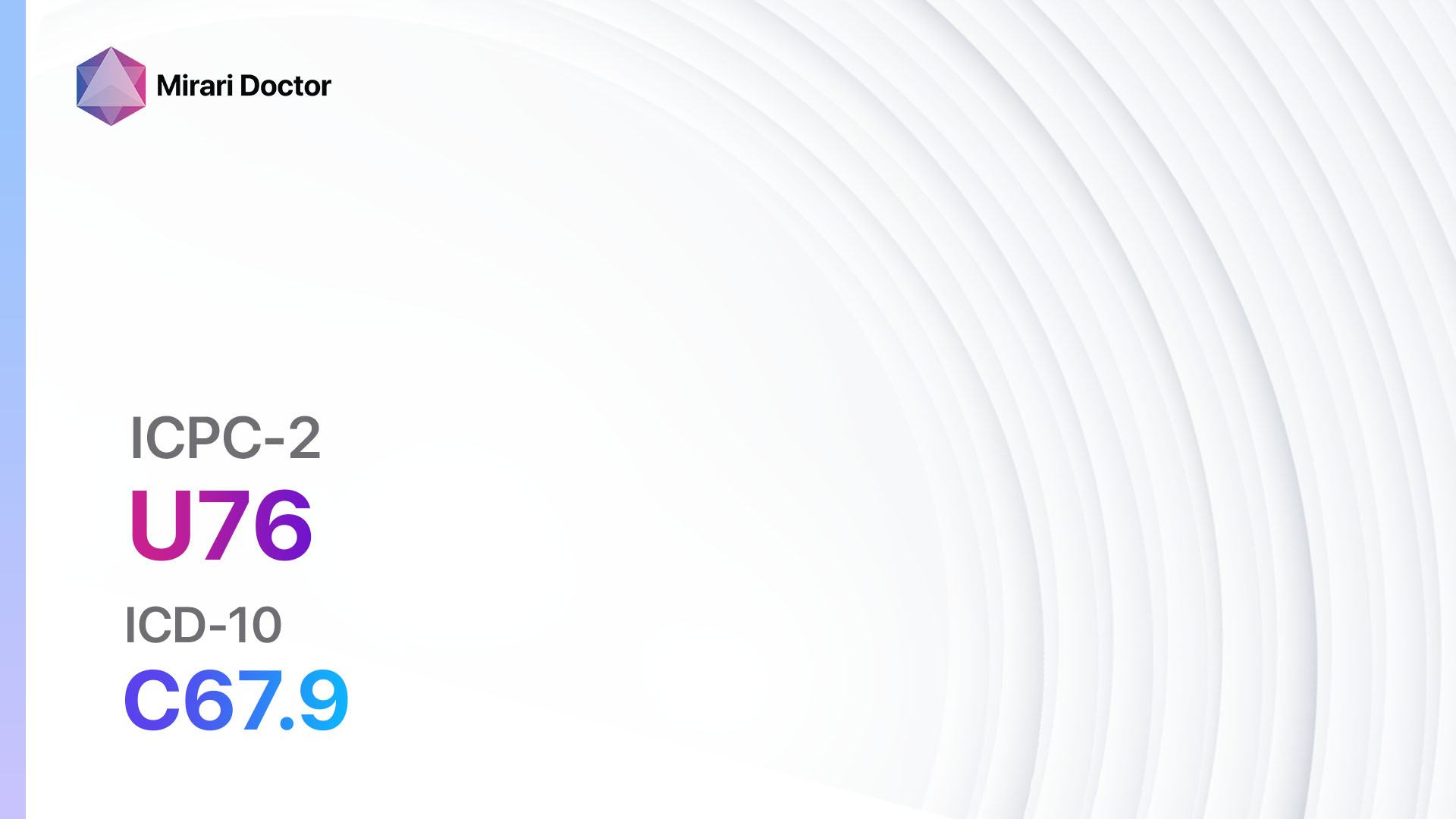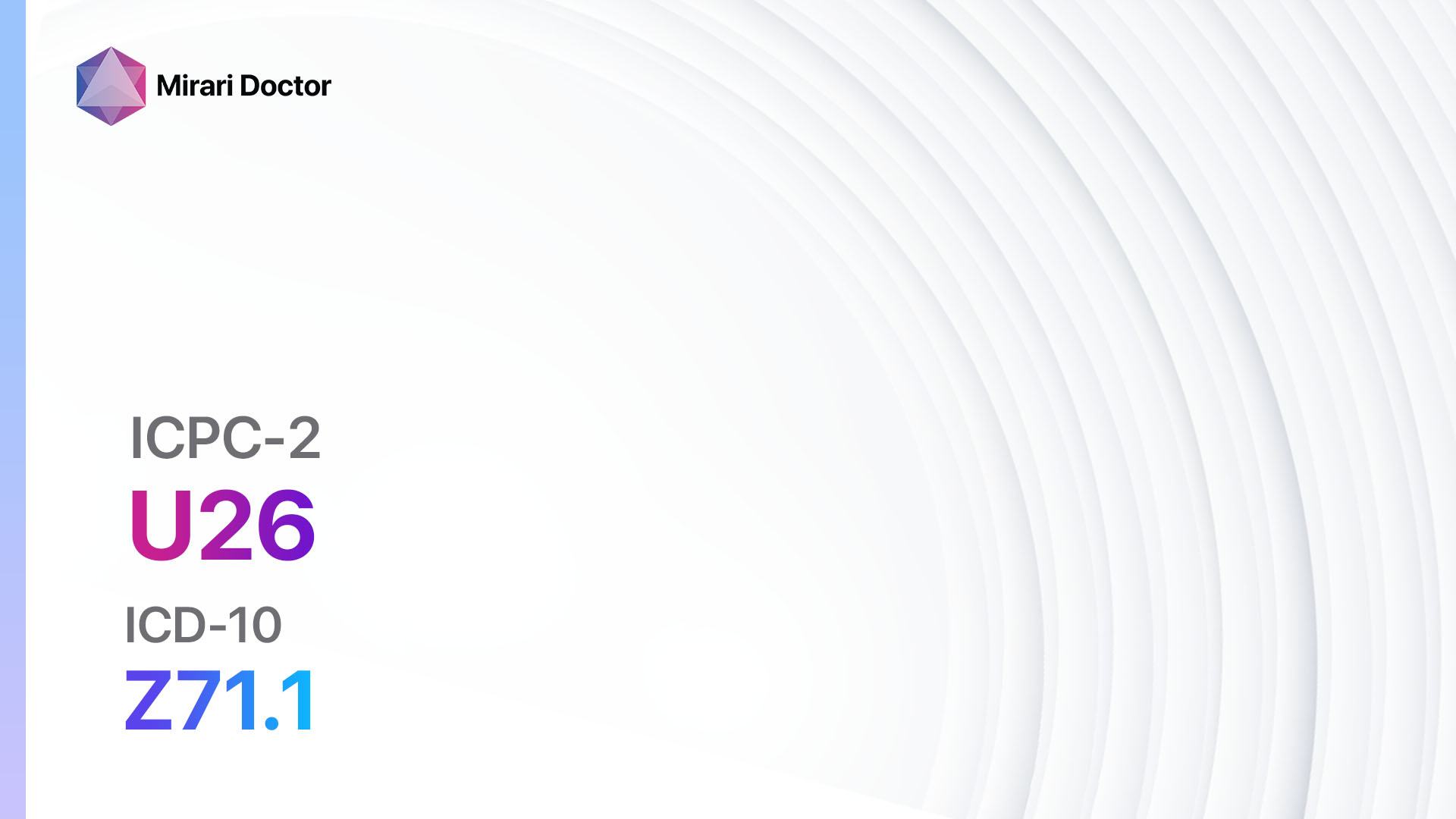
Introduction
Malignant neoplasm of the kidney, also known as kidney cancer, is a serious condition characterized by the abnormal growth of cells in the kidney[1]. It is a significant health concern as it can lead to various complications and has the potential to spread to other parts of the body[2]. The aim of this guide is to provide a comprehensive overview of the diagnosis and possible interventions for malignant neoplasm of the kidney.
Codes
- ICPC-2 Code: U75 Malignant neoplasm of kidney
- ICD-10 Code: C64 Malignant neoplasm of kidney, except renal pelvis
Symptoms
- Blood in the urine (hematuria): This is the most common symptom of kidney cancer and may appear pink, red, or cola-colored[3].
- Back pain: Persistent pain in the lower back or side, not caused by an injury or strain[4].
- Unexplained weight loss: Sudden and unexplained weight loss, often accompanied by loss of appetite[5].
- Fatigue: Feeling tired and weak, even after adequate rest[6].
- Anemia: A decrease in red blood cells, leading to fatigue, shortness of breath, and pale skin[7].
- Swelling in the legs or ankles: Fluid retention due to kidney dysfunction[8].
- A lump or mass in the abdomen: A palpable mass in the abdomen or side[9].
Causes
The exact cause of kidney cancer is unknown, but several factors may increase the risk of developing the disease:
- Smoking: Cigarette smoking is a significant risk factor for kidney cancer[10].
- Obesity: Being overweight or obese increases the risk of kidney cancer.
- High blood pressure: Chronic high blood pressure can increase the risk of kidney cancer.
- Family history: Having a close relative with kidney cancer increases the risk.
- Certain inherited conditions: Conditions such as von Hippel-Lindau disease and hereditary papillary renal cell carcinoma increase the risk of kidney cancer.
Diagnostic Steps
Medical History
- Gather information about the patient’s risk factors, such as smoking history, family history of kidney cancer, and any previous exposure to chemicals or radiation.
- Inquire about the presence of symptoms associated with kidney cancer, such as blood in the urine, back pain, and unexplained weight loss.
- Assess the patient’s medical history for any conditions that may increase the risk of kidney cancer, such as high blood pressure or inherited conditions.
Physical Examination
- Perform a thorough physical examination, including palpation of the abdomen to check for any masses or lumps.
- Check for any signs of fluid retention, such as swelling in the legs or ankles.
- Assess the patient’s overall health and look for any signs of anemia or fatigue.
Laboratory Tests
- Complete blood count (CBC): To check for anemia and evaluate the overall health of the patient.
- Urinalysis: To detect the presence of blood or other abnormalities in the urine.
- Renal function tests: To assess the kidney function and determine if there is any impairment.
- Liver function tests: To evaluate the liver function, as kidney cancer can spread to the liver.
- Coagulation profile: To assess the blood’s ability to clot, as kidney cancer can increase the risk of bleeding.
Diagnostic Imaging
- Ultrasound: A non-invasive imaging technique that uses sound waves to create images of the kidneys and surrounding structures.
- Computed tomography (CT) scan: Provides detailed cross-sectional images of the kidneys, allowing for the detection and evaluation of tumors.
- Magnetic resonance imaging (MRI): Uses magnetic fields and radio waves to create detailed images of the kidneys, providing information about the size and location of tumors.
- Chest X-ray: To check for the presence of lung metastases, as kidney cancer can spread to the lungs.
Other Tests
- Biopsy: A procedure in which a small sample of kidney tissue is removed and examined under a microscope to confirm the diagnosis of kidney cancer and determine the type and stage of the disease.
- Genetic testing: In cases where there is a family history of kidney cancer or suspicion of an inherited condition, genetic testing may be performed to identify specific gene mutations associated with kidney cancer.
Follow-up and Patient Education
- Schedule regular follow-up appointments to monitor the patient’s response to treatment and detect any recurrence or progression of the disease.
- Provide education to the patient and their family about the importance of adhering to treatment plans, managing side effects, and maintaining a healthy lifestyle to reduce the risk of complications.
Possible Interventions
Traditional Interventions
Medications:
Top 5 drugs for Malignant neoplasm of kidney:
- Sunitinib:
- Cost: $10,000-$12,000 per month.
- Contraindications: Hypersensitivity to sunitinib or any of its components.
- Side effects: Fatigue, diarrhea, nausea, vomiting.
- Severe side effects: Cardiotoxicity, hepatotoxicity, hemorrhage.
- Drug interactions: CYP3A4 inhibitors, CYP3A4 inducers.
- Warning: Regular monitoring of blood pressure and liver function required.
- Pazopanib:
- Cost: $9,000-$11,000 per month.
- Contraindications: Hypersensitivity to pazopanib or any of its components.
- Side effects: Diarrhea, hypertension, hair color changes.
- Severe side effects: Hepatotoxicity, QT prolongation, hemorrhage.
- Drug interactions: CYP3A4 inhibitors, CYP3A4 inducers.
- Warning: Regular monitoring of liver function and QT interval required.
- Axitinib:
- Cost: $8,000-$10,000 per month.
- Contraindications: Hypersensitivity to axitinib or any of its components.
- Side effects: Hypertension, diarrhea, fatigue.
- Severe side effects: Hepatotoxicity, hemorrhage, gastrointestinal perforation.
- Drug interactions: CYP3A4 inhibitors, CYP3A4 inducers.
- Warning: Regular monitoring of blood pressure and liver function required.
- Everolimus:
- Cost: $7,000-$9,000 per month.
- Contraindications: Hypersensitivity to everolimus or any of its components.
- Side effects: Stomatitis, rash, fatigue.
- Severe side effects: Pneumonitis, infections, renal failure.
- Drug interactions: CYP3A4 inhibitors, CYP3A4 inducers.
- Warning: Regular monitoring of renal function and blood glucose required.
- Interleukin-2:
- Cost: $6,000-$8,000 per course of treatment.
- Contraindications: Hypersensitivity to interleukin-2 or any of its components, autoimmune disease.
- Side effects: Capillary leak syndrome, flu-like symptoms, hypotension.
- Severe side effects: Organ toxicity, arrhythmias, renal failure.
- Drug interactions: None reported.
- Warning: Requires hospitalization and close monitoring during treatment.
Alternative Drugs:
- Bevacizumab: A monoclonal antibody that inhibits angiogenesis.
- Temsirolimus: An mTOR inhibitor used for advanced renal cell carcinoma.
- Nivolumab: An immune checkpoint inhibitor used for advanced renal cell carcinoma.
- Cabozantinib: A tyrosine kinase inhibitor used for advanced renal cell carcinoma.
- Aldesleukin: A recombinant interleukin-2 used for metastatic renal cell carcinoma.
Surgical Procedures:
- Radical nephrectomy: Surgical removal of the entire affected kidney, along with surrounding tissues and lymph nodes. Cost: $20,000-$30,000.
- Partial nephrectomy: Surgical removal of the tumor and a portion of the kidney, preserving the remaining healthy kidney tissue. Cost: $15,000-$25,000.
- Laparoscopic nephrectomy: Minimally invasive surgery performed through small incisions, using a laparoscope and specialized instruments. Cost: $25,000-$35,000.
- Cryoablation: A procedure that uses extreme cold to destroy cancer cells, performed using a probe inserted into the tumor. Cost: $10,000-$15,000.
- Radiofrequency ablation: A procedure that uses heat to destroy cancer cells, performed using a probe inserted into the tumor. Cost: $10,000-$15,000.
Alternative Interventions
- Acupuncture: May help manage pain and improve overall well-being. Cost: $60-$120 per session.
- Herbal supplements: Some herbs, such as turmeric and green tea, have potential anti-cancer properties. Cost: Varies depending on the specific supplement.
- Mind-body therapies: Techniques such as meditation, yoga, and tai chi may help reduce stress and improve quality of life. Cost: Varies depending on the specific therapy.
- Dietary modifications: A healthy diet rich in fruits, vegetables, and whole grains may help support the immune system and overall health. Cost: Varies depending on food choices.
- Exercise: Regular physical activity can improve strength, endurance, and overall well-being. Cost: Varies depending on the chosen activity.
Lifestyle Interventions
- Smoking cessation: Quitting smoking can significantly reduce the risk of kidney cancer and improve overall health. Cost: Varies depending on the chosen smoking cessation method.
- Weight management: Maintaining a healthy weight through a balanced diet and regular exercise can reduce the risk of kidney cancer. Cost: Varies depending on the chosen weight management program.
- Blood pressure control: Managing high blood pressure through lifestyle modifications and medication can help reduce the risk of kidney cancer. Cost: Varies depending on the chosen blood pressure management strategy.
- Stress management: Techniques such as relaxation exercises, counseling, and support groups can help manage stress and improve overall well-being. Cost: Varies depending on the chosen stress management method.
- Regular medical check-ups: Regular visits to a healthcare provider for screenings and preventive care can help detect kidney cancer at an early stage. Cost: Varies depending on insurance coverage and healthcare provider fees.
It is important to note that the cost ranges provided are approximate and may vary depending on the location and availability of the interventions. It is recommended to consult with a healthcare professional for personalized treatment options and cost estimates.
Mirari Cold Plasma Alternative Intervention
Understanding Mirari Cold Plasma
- Safe and Non-Invasive Treatment: Mirari Cold Plasma is a safe and non-invasive treatment option for various skin conditions. It does not require incisions, minimizing the risk of scarring, bleeding, or tissue damage.
- Efficient Extraction of Foreign Bodies: Mirari Cold Plasma facilitates the removal of foreign bodies from the skin by degrading and dissociating organic matter, allowing easier access and extraction.
- Pain Reduction and Comfort: Mirari Cold Plasma has a local analgesic effect, providing pain relief during the treatment, making it more comfortable for the patient.
- Reduced Risk of Infection: Mirari Cold Plasma has antimicrobial properties, effectively killing bacteria and reducing the risk of infection.
- Accelerated Healing and Minimal Scarring: Mirari Cold Plasma stimulates wound healing and tissue regeneration, reducing healing time and minimizing the formation of scars.
Mirari Cold Plasma Prescription
Video instructions for using Mirari Cold Plasma Device – U75 Malignant neoplasm of kidney (ICD-10:C64)
| Mild | Moderate | Severe |
| Mode setting: 1 (Infection) Location: 3 (Kidney, Liver & Spleen) Morning: 15 minutes, Evening: 15 minutes | Mode setting: 1 (Infection) Location: 3 (Kidney, Liver & Spleen) Morning: 30 minutes, Lunch: 30 minutes, Evening: 30 minutes | Mode setting: 1 (Infection) Location: 3 (Kidney, Liver & Spleen) Morning: 30 minutes, Lunch: 30 minutes, Evening: 30 minutes |
| Mode setting: 3 (Antiviral Therapy) Location: 3 (Kidney, Liver & Spleen) Morning: 15 minutes, Evening: 15 minutes | Mode setting: 3 (Antiviral Therapy) Location: 3 (Kidney, Liver & Spleen) Morning: 30 minutes, Lunch: 30 minutes, Evening: 30 minutes | Mode setting: 3 (Antiviral Therapy) Location: 3 (Kidney, Liver & Spleen) Morning: 30 minutes, Lunch: 30 minutes, Evening: 30 minutes |
| Mode setting: 6 (Liver/Kidney Therapy) Location: 3 (Kidney, Liver & Spleen) Morning: 15 minutes, Evening: 15 minutes | Mode setting: 6 (Liver/Kidney Therapy) Location: 3 (Kidney, Liver & Spleen) Morning: 30 minutes, Lunch: 30 minutes, Evening: 30 minutes | Mode setting: 6 (Liver/Kidney Therapy) Location: 3 (Kidney, Liver & Spleen) Morning: 30 minutes, Lunch: 30 minutes, Evening: 30 minutes |
| Mode setting:7 (Immunotherapy) Location:1 (Sacrum) Morning:15 minutes, Evening:15minutes | Mode setting:7 (Immunotherapy) Location:1 (Sacrum) Morning:30 minutes, Lunch:30 minutes, Evening:30 minutes | Mode setting:7 (Immunotherapy) Location:1 (Sacrum) Morning:30 minutes, Lunch:30 minutes, Evening:30 minutes |
| Total Morning:60minutesapprox.$10USD, Evening:60minutesapprox.$10USD | Total Morning:120minutesapprox.$20USD, Lunch:120minutesapprox. $20 USD, Evening:120minutesapprox. $20 USD, | Total Morning:120minutesapprox.$20USD, Lunch:120minutesapprox. $20 USD, Evening:120minutesapprox. $20 USD, |
| Usualtreatmentfor7-60daysapprox.$140USD–$1200USD | Usualtreatmentfor6-8weeksapprox.$2,520USD–$3,360USD | Usualtreatmentfor3-6monthsapprox.$5,400USD–$10,800USD |
 |
|
Use the Mirari Cold Plasma device to treat Malignant neoplasm of kidney effectively.
WARNING: MIRARI COLD PLASMA IS DESIGNED FOR THE HUMAN BODY WITHOUT ANY ARTIFICIAL OR THIRD PARTY PRODUCTS. USE OF OTHER PRODUCTS IN COMBINATION WITH MIRARI COLD PLASMA MAY CAUSE UNPREDICTABLE EFFECTS, HARM OR INJURY. PLEASE CONSULT A MEDICAL PROFESSIONAL BEFORE COMBINING ANY OTHER PRODUCTS WITH USE OF MIRARI.
Step 1: Cleanse the Skin
- Start by cleaning the affected area of the skin with a gentle cleanser or mild soap and water. Gently pat the area dry with a clean towel.
Step 2: Prepare the Mirari Cold Plasma device
- Ensure that the Mirari Cold Plasma device is fully charged or has fresh batteries as per the manufacturer’s instructions. Make sure the device is clean and in good working condition.
- Switch on the Mirari device using the power button or by following the specific instructions provided with the device.
- Some Mirari devices may have adjustable settings for intensity or treatment duration. Follow the manufacturer’s instructions to select the appropriate settings based on your needs and the recommended guidelines.
Step 3: Apply the Device
- Place the Mirari device in direct contact with the affected area of the skin. Gently glide or hold the device over the skin surface, ensuring even coverage of the area experiencing.
- Slowly move the Mirari device in a circular motion or follow a specific pattern as indicated in the user manual. This helps ensure thorough treatment coverage.
Step 4: Monitor and Assess:
- Keep track of your progress and evaluate the effectiveness of the Mirari device in managing your Malignant neoplasm of kidney. If you have any concerns or notice any adverse reactions, consult with your health care professional.
Note
This guide is for informational purposes only and should not replace the advice of a medical professional. Always consult with your healthcare provider or a qualified medical professional for personal advice, diagnosis, or treatment. Do not solely rely on the information presented here for decisions about your health. Use of this information is at your own risk. The authors of this guide, nor any associated entities or platforms, are not responsible for any potential adverse effects or outcomes based on the content.
Mirari Cold Plasma System Disclaimer
- Purpose: The Mirari Cold Plasma System is a Class 2 medical device designed for use by trained healthcare professionals. It is registered for use in Thailand and Vietnam. It is not intended for use outside of these locations.
- Informational Use: The content and information provided with the device are for educational and informational purposes only. They are not a substitute for professional medical advice or care.
- Variable Outcomes: While the device is approved for specific uses, individual outcomes can differ. We do not assert or guarantee specific medical outcomes.
- Consultation: Prior to utilizing the device or making decisions based on its content, it is essential to consult with a Certified Mirari Tele-Therapist and your medical healthcare provider regarding specific protocols.
- Liability: By using this device, users are acknowledging and accepting all potential risks. Neither the manufacturer nor the distributor will be held accountable for any adverse reactions, injuries, or damages stemming from its use.
- Geographical Availability: This device has received approval for designated purposes by the Thai and Vietnam FDA. As of now, outside of Thailand and Vietnam, the Mirari Cold Plasma System is not available for purchase or use.
References
- Cleveland Clinic. Kidney Cancer: Symptoms, Signs, Causes & Treatment.//my.clevelandclinic.org/health/diseases/9409-kidney-cancer-overview
- StatPearls. Renal Cancer.//www.ncbi.nlm.nih.gov/books/NBK558975/
- Mayo Clinic. Kidney cancer – Symptoms and causes.//www.mayoclinic.org/diseases-conditions/kidney-cancer/symptoms-causes/syc-20352664
- NHS. Symptoms of kidney cancer.//www.nhs.uk/conditions/kidney-cancer/symptoms/
- American Cancer Society. Tests for Kidney Cancer. //www.cancer.org/cancer/types/kidney-cancer/detection-diagnosis-staging/how-diagnosed.html
- NCI. Hereditary Kidney Cancer Syndromes.//www.cancer.gov/types/kidney/patient/kidney-genetics-pdq
- UF Health. Patient education – Kidney cancer.//ufhealth.org/conditions-and-treatments/kidney-cancer/patient-education
- Cancer Research UK. Follow up for kidney cancer.//www.cancerresearchuk.org/about-cancer/kidney-cancer/treatment/follow-up
- PMC. Imaging Advances in the Management of Kidney Cancer.//www.ncbi.nlm.nih.gov/pmc/articles/PMC6299343/
- Crotty, Thomas B. ; Farrow, George M. ; Lieber, Michael M. (1995). Chromophobe Cell Renal Carcinoma: Clinicopathological Features of 50 Cases. DOI: 10.1016/S0022-5347(01)66944-1
Related articles
Made in USA



























